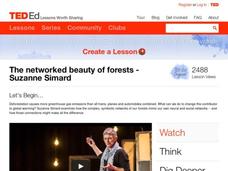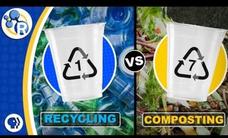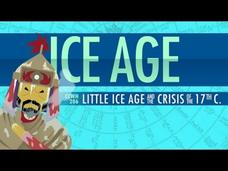PBS
Career Connections | Environmental Scientist
The narrator of a short video shares his passion for environmental science and the importance of his work to research the human and climate factors that impact the environment.
Crash Course
Climate Science: Crash Course History of Science #45
Climate change fears are nothing new—scientists have been concerned about the issue since the early 1900s. Viewers learn the history of the study of climate in a quick but thorough video lesson. The instructor describes where climate...
California Academy of Science
What is the Environmental Impact of Feeding the World?
One in every seven people suffer from a lack of basic food. Our Hungry Planet introduces this complex issue in the second lesson of an interesting 13-part unit. It discusses the space needed to grow and raise food, the transportation of...
Bozeman Science
LS3B - Variation of Traits
Make sure your unit on trait variation causes a sensation! Take an in-depth look at standard LS3B, an important component of the Next Generation Science Standards. The narrator discusses methods of delivering the standard to younger...
Be Smart
97% of Climate Scientists Really Do Agree
Why do some people still question climate change? Discover the components of consensus with a video from a well-written science playlist. The narrator guides viewers through the process of reviewing climate publications, how exclusive...
TED-Ed
The Networked Beauty of Forests
Forests are like Facebook, a social network of trees and other organisms that support and provide for each other. Professor Suzanne Simard describes how forests are wired for healing, but that they need our help. This video would be a...
TED-Ed
How Quantum Mechanics Explains Global Warming
What do quantum mechanics and global warming have to do with each other? More than you might think. Surprisingly, this video explains how it's not the energy emitted from the sun that causes the problem, but how the infrared radiation...
Fuse School
Acid Rain
Rain, rain, go away ... at least if your pH is below six! The sixth installment in a series of seven videos teaching about pollution and our atmosphere shows learners the facts about acid rain. Embedded pauses allow you to stop and check...
Curated OER
We Are All Earthlings
The animals all sing about the earth. This would be a great video to show during a unit about environmental stewardship.
Be Smart
Is Height All in Our Genes?
Humans on average are shorter than they were centuries ago. Young scholars analyze the factors that affect the height of individuals including historical trends in a video lesson. The presentation analyzes both genetic and...
American Chemical Society
Can Plastic Be Composted?
Some plastics market as green, but are they really? Turns out, the question is a complicated one. A video lesson describes how these new plastics may have some decomposing properties but need a little boost from industry. The lesson...
Fuse School
Nitrogen Cycle
In an atmosphere that contains so much unusable nitrogen, how do organisms get the nitrogen they need to survive? The narrated video discusses how atmospheric nitrogen is converted into the materials we need to build proteins in our...
Fuse School
Green Chemistry - Principle 6
Using a catalyst to reduce reaction times is often necessary for a reaction to be profitable. But are all catalysts safe? The sixth installment in a 12-part Green Chemistry series has learners explore the role of catalysts in industrial...
TED-Ed
Cloudy Climate Change: How Clouds Affect Earth's Temperature
While clouds may not make for the most enjoyable weather, they play an important role when it comes to regulating the temperature of the earth. Watch this video and learn how these giant masses of water droplets actually help to...
Be Smart
Inside the World of Fire Ants!
Did you know that fire ant colonies are seen as small mounds on the surface of Earth but underground, tunnels can extend as far as 25 feet away? Viewers learn about the unique history of fire ants, from the pain of their sting to their...
American Chemical Society
How Does Salt Melt Ice?
Much like the ice on roadways, common sodium chloride has been melting away snow days for many a year! Explore the colligative property freezing point depression through an interesting video from the American Chemical Society Reactions...
Amoeba Sisters
Genetic Drift
Survival is a game of chance, catch my drift? Examine the factors that influence genetic drift with an entertaining video from a large biology playlist. The resource covers the myriad conditions that come into play when a species...
SciShow
How to Live Forever? Be a Jellyfish
The turritopsis dohrnii, or immortal jellyfish, are tiny, with adults measuring only 0.18 inches tall and wide. The narrator of this short video explores the immortal jellyfish and the importance of their unique and amazing lives. These...
Veritasium
Why Are 96,000,000 Black Balls on This Reservoir?
A Los Angeles reservoir is the largest ball pit on Earth. Learn the problem and solution of the water treatment plant in LA in a Veritasium video lesson. An unexpected chemical reaction created an issue in the treatment of water, and the...
California Academy of Science
Think Before You Eat
Small changes in individual diets add up quickly, which is the theme of the ninth lesson in the 13-part Our Hungry Planet unit. Viewers watch a video to learn basic facts before reading a handout and discussing their own choices.
California Academy of Science
Desalination
Desalination requires around two gallons of sea water to make one gallon of fresh water—that's quite a ratio! Viewers consider the pros and cons of desalination as one option to providing fresh water. They learn about two different...
California Academy of Science
Vertical Farming
Half of crops from traditional farming never get harvested, while 90 percent of crops from vertical farming go into the food supply. As land runs out for farming and the need for crops increases, could vertical farming solve the problem?...
California Academy of Science
Buses and Biofuels: Sustainable Transportation
One-third of all carbon emissions comes from transportation in the United States. The third lesson in a 13-part series on Exploring Energy offers ideas on how to reduce emissions from cars, airplanes, large trucks, and more.
Crash Course
Climate Change, Chaos, and The Little Ice Age - Crash Course World History 206
Can climate change contribute to political unrest? Explore this intriguing question with a video from Crash Course World History that examines the Little Ice Age from the thirteenth to the nineteenth centuries, particularly in the...























